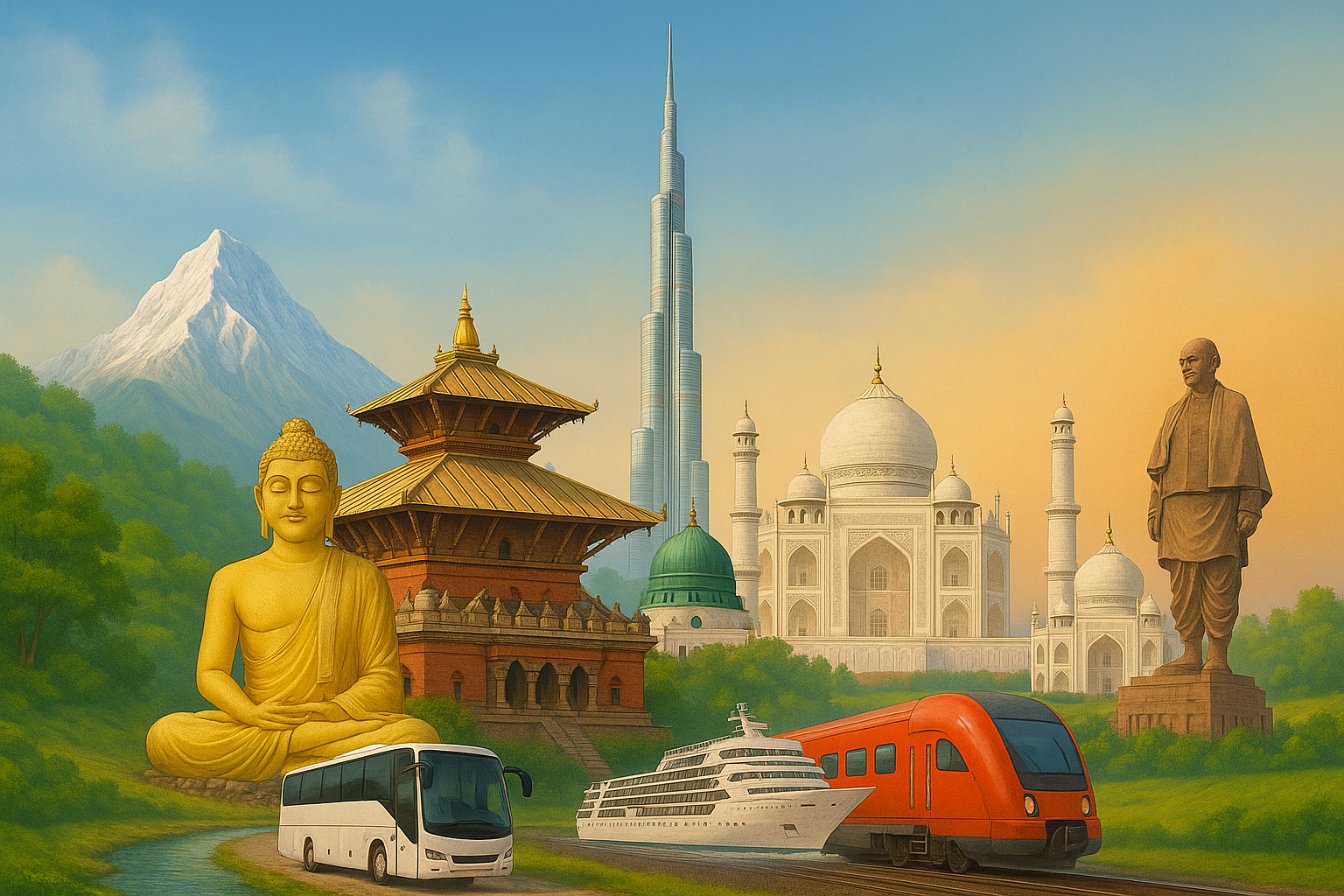1. Introduction
The history of travel and tourism is as old as human civilization itself. In the earliest days, people traveled in search of food, water, and shelter — marking the beginning of human mobility. Over time, travel evolved for trade, education, religion, adventure, and leisure. Today, travel and tourism have grown into one of the largest and most influential global industries, contributing significantly to employment, cultural exchange, and economic development worldwide.
2. Historical Background of Travel and Tourism
Tourism has ancient roots and has continuously evolved with human progress.
- Ancient Civilizations: In ancient Egypt and Rome, wealthy citizens traveled for recreation and pilgrimage. The pyramids, temples, and Roman resorts attracted visitors from various regions.
- Religious Pilgrimages: Pilgrimage has been a major motivation for travel since antiquity — to Mecca for Muslims, to Varanasi for Hindus, to Lumbini for Buddhists, and to Jerusalem for Christians.
- The Industrial Era: The 18th and 19th centuries marked a turning point with the invention of steamships, railways, and later airplanes. Travel became faster, cheaper, and more accessible.
- Post–World War Development: After World War II, improved peace, prosperity, and transportation led to an explosion of international tourism. In 1945, the United Nations began recognizing tourism as a key driver of peace and cooperation among nations.
3. Present Global Situation of Tourism
In the 21st century, tourism has become one of the largest global industries.
- Global Statistics (as of 2024): According to the UN World Tourism Organization (UNWTO), over 1.3 billion people travel internationally every year.
- Economic Contribution: Tourism contributes nearly 10% to the world’s Gross Domestic Product (GDP).
- Employment Creation: Around 300 million people worldwide are directly or indirectly employed in tourism-related sectors.
- Top Tourist Destinations: Europe, Asia-Pacific, and the Americas dominate global tourism. France, Spain, Italy, the USA, China, Japan, Malaysia, and Thailand are among the most visited countries.
Although the COVID-19 pandemic heavily disrupted the sector between 2020–2022, it has rapidly recovered in recent years. The use of digital booking platforms, budget airlines, and destination marketing has revitalized global tourism.
4. Types of Tourism and Modern Trends
Today, tourism has diversified into multiple specialized forms:
- Cultural Tourism: Exploring history, art, traditions, and heritage.
- Adventure Tourism: Trekking, mountain biking, skydiving, skiing, etc.
- Eco-Tourism: Visiting natural environments while promoting conservation.
- Medical and Wellness Tourism: Traveling for treatment, yoga, meditation, and spa experiences.
- Digital Nomad Tourism: Remote workers traveling while working online — a rapidly growing trend after the pandemic.
Such diversification has expanded business opportunities and generated sustainable income sources worldwide.
5. Positive Impact of Tourism on the Global Economy
- Employment Generation
Tourism provides millions of jobs — from hotels, restaurants, and airlines to handicrafts and local transport. For developing countries, it is one of the most effective sources of employment. - Foreign Exchange Earnings
Tourists spend large amounts of foreign currency, improving the balance of payments and strengthening the national economy. Countries like Thailand, Nepal, Maldives, and Indonesia depend heavily on tourism revenue. - Infrastructure Development
Tourism encourages the construction of roads, airports, communication systems, and accommodation facilities, which also benefit local communities. - Cultural Preservation
Tourists’ interest in local traditions, crafts, and cultural heritage motivates communities to preserve and promote them. - Global Peace and Cooperation
International travel fosters cross-cultural understanding, tolerance, and friendship among nations, helping to maintain global peace and harmony.
6. Challenges and Solutions
Despite its benefits, tourism faces several challenges:
- Environmental Degradation: Uncontrolled tourism can cause pollution and resource depletion.
- Cultural Distortion: Excessive commercialization may erode traditional lifestyles and values.
- Unequal Distribution of Benefits: Economic gains often concentrate in major destinations, leaving rural areas neglected.
Possible Solutions:
- Promote sustainable tourism practices.
- Involve local communities in decision-making and benefit-sharing.
- Use eco-friendly technologies and renewable resources.
- Strengthen cultural protection laws and responsible tourism education.
7. Future Prospects of Global Tourism
The future of tourism is bright, dynamic, and technology-driven:
- Artificial Intelligence (AI) and Virtual Reality (VR) will personalize travel experiences and planning.
- Space Tourism is emerging as a new frontier, with private companies investing in commercial space travel.
- New Destinations: Africa, South Asia, and Eastern Europe are rising as affordable and attractive alternatives to traditional destinations.
- Sustainable Development Goals (SDGs): Tourism will play a central role in achieving global economic, environmental, and social sustainability.
8. Conclusion
In conclusion, travel and tourism are not merely recreational activities but essential components of global development. Their history is intertwined with human progress, and their present role in shaping the global economy is undeniable. The sector promotes employment, foreign investment, cultural exchange, and environmental awareness.
If managed responsibly, tourism can serve as a long-term engine for peace, prosperity, and mutual understanding. It brings people together, bridges cultural divides, and spreads a universal message — that the world is one family, united through exploration, respect, and shared experience.

Leave a Reply